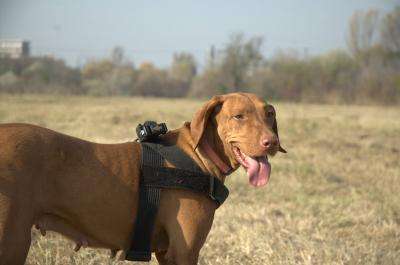A new paper has demonstrated the power of path tracking to measure social behavior and automatically determine dogs' personalities.
How dogs behave during walks reveals a lot about traits such as trainability, controllability, aggression, age and dominance. Dogs that consistently took the lead were more responsive to training, more controllable, older and more aggressive than the dogs that tended to follow.
Dogs that led more often had higher dominance ranks in everyday situations, assessed by a dominance questionnaire.
"The dominance questionnaire tells us the pecking order of dog groups by quantifying interactions between pairs," said Dr. Enikő Kubinyi, senior author of the study from the Hungarian Academy of Sciences. "For example, the dogs that bark first and more when strangers enter the house, eat first at meals and wins fights are judged as more dominant. Conversely, dogs that lick other dogs' mouths more often are less dominant as this is a submissive display."

A typical walk of the group and the illustration of returning loops. (A) Highly detailed trajectories of the dogs (only Vizslas are shown) and of the owner during a 30-minute walk. Arrows indicate the direction of motion. (B) The dogs run in loops and return from time to time to the owner. Thickened segments of the tracks show when a dog's return to its owner was found by their automated method.
doi:10.1371/journal.pcbi.1003446.
Pack leadership is well-established in wolves, where packs are typically led by a single breeding pair, but there is still much debate as to whether groups of domestic dogs have a social hierarchy.
"These dogs have no breeding pair," said Kubinyi. "However, there are dogs who take the lead more often than others. On average, an individual took the role of the leader in a given pair in about three quarters of the time. This ratio is of similar magnitude to the case of wild wolf packs with several breeding individuals. Using this qualitative data over longer time scales allows us to see the more subtle relationships that might otherwise be missed. Of course, hierarchies are likely to vary across breeds and individual groups, so we hope to use this technology on other animals in future to investigate further."
Directional correlations between tracks of dog pairs, the resulting leadership network and the results of the dominance questionnaire. (A) Directional correlation delay time (τ) values for a given pair (V3 and V4) when high correlation was found for a time window shown by the grey histogram, while the blue curve shows the function gained by Gaussian smoothing with σ = 0.3 s. The distribution shows a clear peak at τ* = 0.6 s. For a comparison, the red curve shows a directional correlation delay time function for another pair (M and V4), where no connection was found between the two dogs in the absence of a significant peak. (B) Summarized leadership network composed of the directional delay time values. Each directed link points from the individual that plays the role of the leader more often in the given relationship toward the follower. The grey link shows a strong connection between V3 and V5 with an evenly matched relationship (τ* = 0 s). The upper values on the edges indicate the mode of time delays in seconds and the lower values show the average portion that the leader of that pair was actually leading. Note that these modes are from wide distributions (as shown on panel A) with an average full width at half maximum of 3.7 s. The mixed-breed (M) is not connected to any Vizslas, and so is not part of the network. This network is used to calculate leading tendency, which is the number of followers that can be reached traveling through directed links. (C) Dominance network between the dogs derived from the dominance questionnaire [29]. Each directed edge points from the dominant individual toward the subordinate one. The colors represent the context when dominance is evident: red: barking, orange: licking the mouth, green: eating and blue: fighting (see more details in Text S1). The nodes were arranged in the vertical direction in such a way that more edges point downwards than upwards between all pairs. doi:10.1371/journal.pcbi.1003446
The dogs used in this study were of the Vizsla breed, a Hungarian hunting dog known for their good-natured temperament and trainability. The authors stress that the leader-follower relationships were always voluntary; dogs chose who to follow and the leaders did not compel other dogs to follow them.
The technology used in the study could be applied to other dogs used for search and rescue to provide quantitative data allowing handlers to compare how different dogs work together and pick those with the highest compatibility. Each device weighs only 14 grams and further sensors such as gyroscopes could be used to determine what each animal is doing at a given time.

A Vizsla dog wearing high-precision GPS harness, data from which was used to determine dogs' social rankings. Credit: Zsuzsa Ákos





Comments